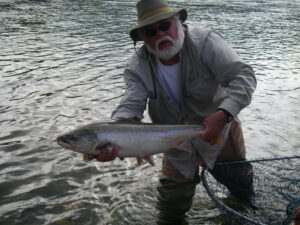Salmon : Why Aren’t They Big as They Used to Be?

By Randy Spencer
If you talk to old-timers who fished the great salmon lakes of Maine—Moosehead, Sebago, East Grand, or West Grand—in the 1950s and ’60s, you’ll hear stories of hefty landlocked salmon tipping the scales at five, six, even eight pounds with regularity. Back then, a 20-inch salmon wasn’t a bragging right; it was the norm. Today, by contrast, a four-pound fish turns heads. What happened?
The answer lies not in any single factor, but a convergence of ecological changes, management decisions, invasive species, and even cultural shifts in how we fish and what we expect from our fisheries. Understanding the decline in salmon size means looking at the ecosystem as a whole, and it begins with their food.
In the mid-20th century, landlocked salmon thrived in lakes that supported robust populations of rainbow smelt. Smelt are small, oily, high-protein forage fish that salmon evolved alongside. In lakes where smelt were abundant and well distributed, salmon grew fast and fat. But in many Maine lakes, smelt numbers have declined dramatically due to overpredation, habitat loss, and competition with invasive species like alewives and white perch.
Alewives
Alewives, for instance, now compete with smelt for zooplankton and can even prey on young smelt. White perch, a species not native to many of Maine’s larger salmon lakes, also compete with juvenile salmon and smelt. The result? A disrupted food web in which salmon must work harder to find high-quality forage—and often come up short.
Another key factor is how we manage the fishery. In the heyday of big salmon, stocking was less aggressive, and wild reproduction in many lakes supplemented hatchery input. Today, due to increased fishing pressure and habitat degradation, stocking levels have risen to maintain catch rates. This keeps anglers happy in the short term but can result in too many mouths to feed.
Too many salmon chasing too few smelt leads to stunted fish. When there’s intense competition for a limited food source, growth slows and condition deteriorates. Managers walk a tightrope: reduce stocking to improve fish size and risk angler dissatisfaction, or keep stocking high and accept a population of smaller fish.
Climate change adds another layer of complexity. Salmon are coldwater fish. They thrive in deep, cool, oxygen-rich waters. But warmer summers have created what’s called a “thermal squeeze”—where the cold water salmon need drops below oxygen thresholds, and the oxygenated water they can breathe gets too warm to support healthy metabolism. This constricts their livable zone, particularly in mid-to-late summer, making it harder for salmon to chase smelt or grow efficiently. Moreover, warmer surface waters can disrupt smelt spawning and increase stratification in lakes, further isolating forage and making them less accessible to salmon.
Winter Fishing
Seventy-five years ago, winter fishing for salmon was almost unheard of. Today, with lighter gear, sonar, better bait preservation, and a culture of winter recreation, ice fishing pressure on landlocked salmon is significantly higher. Even if mortality from ice fishing is modest, it can skew age structures in salmon populations. Fewer fish live long enough to reach trophy size, especially when combined with heavy summer pressure.
In the mid-20th century, it was Carrie Stevens flies and the occasional Dave Davis. Now, it’s downriggers, planer boards, GPS trolling paths, and fish finders. This boosts catch rates but also increases the harvest of larger, older fish, further reducing the odds of encountering a “silver football” salmon.
There’s also the matter of angler expectation. Fisheries biologists today manage many lakes for “high catch rates of legal-sized fish” rather than trophies. For a family outing or casual day trip, catching a few two-pound salmon can be a great experience. But for those who remember the deep-bodied brutes of yesteryear, the change is stark.
Some lakes—like Moosehead and Sebago—are still capable of producing large salmon, especially when smelt populations bounce back and careful slot limits are enforced. But those lakes are the exception now, not the rule.
Trophy Salmon
Is rebuilding a fishery that consistently produces trophy landlocked salmon even possible today? If it were, it would have to include managing predator-prey balance, reducing salmon stocking in overpopulated lakes, restoring smelt habitat, and limiting harvest of older fish, possibly through stricter slot limits or seasonal closures. It also means acknowledging that Maine’s salmon lakes are dynamic ecosystems, facing pressures unimaginable in the 1950s.
So no, the salmon aren’t getting as big as they used to—but the tools to help them rebound do exist. Does the will to do it exist? It’s a matter of choosing what kind of fishery we want, and being willing to accept trade-offs in the name of quality.
For more articles about hunting,fishing and the great outdoors, be sure to subscribe to the Northwoods Sporting Journal.
